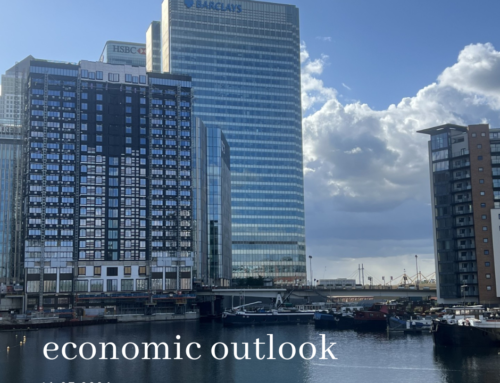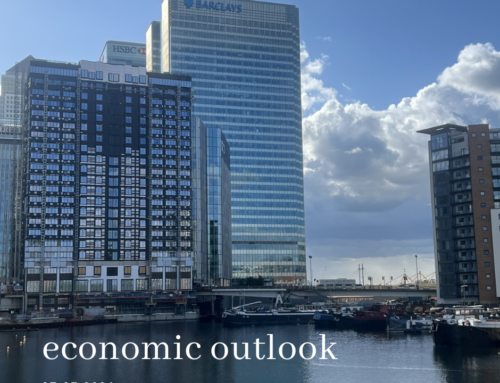| USA The trade deficit widened from $58.7 billion to $61.5 billion. Good imports increased $7.0-billion (to $263.0 billion), led by cell phones/other household goods (+$1.8 billion), passenger cars (+1.7 billion), and computer accessories (+$0.4 billion). Goods exports, for their part, climbed $5.3 billion on gains for civilian aircraft (+$1.0 billion), gem diamonds (+$0.8 billion), and other petroleum products (+$0.5 billion). Seeing how imports outpaced exports, the goods trade deficit widened from $84.6 billion to $86.3 billion. Country by country, the U.S. goods deficit widened with China (from $22.7 billion to $24.1 billion) and Canada (from $5.4 billion to $5.9 billion) but narrowed with the European Union (from $17.8 billion to $16.8 billion). The services surplus, meanwhile, shrank from $25.9 billion in August to $24.7 billion in September as imports rose 2.63% while exports edged up only 0.40%. Travel exports continued to recover but stayed below their pre-pandemic level. Inversely, travel imports, which serve as a proxy for the number of Americans travelling abroad, held above their pre-pandemic level The University of Michigan Consumer Sentiment index decreased from 63.7 in October to 60.4 in November. The deterioration of sentiment in November was due to a worse assessment of both longer-term perspectives (from 59.3 to 56.9) and current conditions (from 70.6 to 65.7). Twelve-month inflation expectations rose from 4.2% to 4.4%, while 5/10-year expectations crawled up two ticks from 3.0% to 3.2%, a twelve-year high. The sub-index tracking whether consumers consider now to be a good time to buy a home fell from 44.0 to 33.0, an all-time low (on a par with November 2022). This is consistent with the National Association of Realtors’ housing affordability index, which stands at a record low In the wake of the most recent Federal Open Market Committee meeting and a softer-than-expected employment report, US bond yields slipped quite substantially, and enough, it would appear, to prompt Fed Chair Powell to caution markets not too loosen financial conditions excessively. Powell warned markets that the Fed won’t hesitate to tighten more if appropriate and said he is not confident that the central bank has achieved the policy stance necessary to hit its 2% inflation target. Markets reacted by tightening conditions, pushing bond yields and the dollar higher and equities lower. They now believe the Fed’s first rate cut will occur in July of next year rather than in June The Fed’s Senior Loan Officer Opinion Survey shows that bank lending standards remained tight over the past quarter and that demand for credit stayed weak. Though there were pockets of improvement, the survey reports metrics that have historically corresponded with recessions. Regarding loans to businesses, survey respondents, on balance, report tighter standards and weaker demand over the third quarter for commercial and industrial loans to firms of all sizes. The same goes for all commercial real estate loan categories. For loans to households, banks report that lending standards tightened across all categories of residential real estate loans other than government residential mortgages, for which standards generally remain unchanged Credit card balances are now $154 billion higher than they were a year ago, the largest annual increase since the Federal Reserve Bank of New York began tracking the data in 1999, researchers said in a blog post. The increase in balances is consistent with strong nominal spending and real GDP growth over the same timeframe, the bank said, while noting that delinquencies have been rising from record-low levels The Fed’s reverse repo facility fell below $1 trillion this week for the first time in two years as investors increasingly purchase Treasury bills rather than park funds at the Fed. The use of the facility peaked at over $2.5 trillion at the end of 2022 A poorly received 30-year US Treasury bond auction prompted a backup in yields on Thursday afternoon as the issue tailed over five basis points to 4.769% from 4.716% at the auction deadline The major indexes finished mixed for the week, but not before the S&P 500 Index came close to matching its longest winning streak in nearly two decades—on Wednesday, the S&P 500 notched its eighth straight gain, while the Nasdaq Composite Index marked its ninth. The market’s strength was exceptionally narrow, however, with an equally weighted version of the S&P 500 Index lagging its market-weighted counterpart by 190 basis points, and the Russell 1000 Value Index trailing its growth counterpart by 404 basis points—the largest margin since March. It was one of the final weeks of major third-quarter corporate earnings releases, and upside surprises from some technology-oriented firms appeared to provide support to the growth indexes. In particular, high-valuation software stocks seemed to get a general boost from cloud monitoring and security firm Datadog, which surged 28% on Tuesday following stronger-than-expected earnings and guidance In terms of data release, CPI is out Tuesday. Inflation’s descent has been slower going. The Consumer Price Index rose slightly stronger than expected in September, holding the YoY rate steady at 3.7%. Core inflation continued to moderate on a year-ago basis, falling 0.2 percentage points to 4.1%. Since the end of September, gas prices have steadily fallen and food inflation has appeared to move sideways. If realized, that would be the smallest monthly gain since May. Yet, the modest rise will likely be overshadowed by continued strength in the core CPI. Core services excluding shelter (i.e., “super-core” CPI) is poised for another solid gain, helped along by health insurance reversing its deflationary trend and firmness in transportation services. Core goods prices are shaping up to be a small drag, as partial rebounds in auto parts, apparel and medical goods look likely Retails sales is out on Wednesday. The staying power of the consumer has been on full display this year. Retail sales beat expectations the past three months straight and were up 3.4% year-over-year in September. Stronger-than-expected sales underpinned real personal consumption expenditures’ 4.0% annualized growth rate in Q3, the fastest pace since 2021. Some payback is likely in store. Real disposable income has slipped the past four months, excess liquidity has dwindled and credit growth has slowed. While these factors did not appear to weigh on the consumer this summer, the impressive run will be difficult to sustain as prices and borrowing costs remain elevated. UK GDP for Q3 has come out flat at 0.0% QoQ, 0.6% YoY, monthly GDP for September was flat at 0.2% MoM. Industrial Production for September was also flat at 0.0% MoM, 1.5% YoY, while Business Investment in Q3 fell by -4.2% following two quarters of strong growth (+4.1% in Q2). The UK’s Goods trade balance was -GBP14.3bn, the overall trade balance improving to GBP1.6bn. The main GDP drivers were a slight fall of 0.1% in services, which was countered by a 0.1% increase in constriction output. There are two main factors that need to be considered in all of this. Firstly, there were a number of public sector strikes in September, which will have dampened output. Secondly, the wet, albeit warm, weather that dominated the latter part of this past summer will have dampened consumption and put off shopping for the autumn. The more positive news is that real earnings continue to increase, forecast to rise by 1% in Q4, and as such this should slowly boost consumer confidence (there is ample scope for improvement) and expenditure. Overall GDP is flat, but the broader picture seems one of stagnation Bank of England (BoE) Governor Andrew Bailey said at a central bank conference in Ireland that it was “really too early” to talk about cutting interest rates. He spoke after BoE Chief Economist Huw Pill said that financial markets pricing in an initial rate cut in August next year “doesn’t seem totally unreasonable,” which triggered a sharp decline in short-dated government bond yields. EU European Central Bank (ECB) President Christine Lagarde said it will take more than “the next couple of quarters” for the ECB to start cutting rates. The yield on Germany’s 10-year government bond rose above 2.7%. Italian bond yields also ticked higher. UK bond yields endured a roller coaster ride after data showed the economy stagnated in the third quarter Retail sales in the eurozone fell 0.3% in September, after declining 0.7% in August. The economic sentiment index produced by the Sentix consultancy came in at -18.6 in November, an improvement from the -21.9 recorded in the previous month. In Germany, industrial production in September fell 1.4% sequentially, after flatlining in August, while manufacturing orders increased 0.2%—well below the 1.9% registered in the previous month. In France and Italy, industrial output was flat in September compared with August In local currency terms, the pan-European STOXX Europe 600 Index ended 0.21% lower as optimism about a peak in interest rates dimmed. Major stock indexes were mixed. France’s CAC 40 Index was roughly flat, Germany’s DAX gained 0.30%, and Italy’s FTSE MIB tumbled 0.59%. CHINA The latest readings underscored the fragility of China’s economy and appeared to add to concerns that growth has not yet bottomed. Despite Beijing’s recent efforts to prop up demand, many economists predict that the government will introduce further stimulus measures to counter deflationary pressures The consumer price index fell 0.2% in October from the prior-year period, after remaining unchanged in September, as lower pork prices weighed on food prices. Meanwhile, the producer price index dropped 2.6% from a year ago, marking the 13th consecutive month of decline Overseas exports declined 6.4% in October from a year earlier, surpassing the 6.2% fall in September, amid weaker global demand. However, imports unexpectedly rose by 3%, reversing the 6.2% contraction in September and marking the first year-on-year growth since September 2022. Overall trade surplus fell to a below-consensus USD 56.5 billion, down from September’s USD 77.71 billion Chinese equities rose as investors remained broadly unmoved by data showing that consumer prices slipped back into contraction, reviving the specter of deflation hanging over the economy. The Shanghai Composite Index rose 0.27%, while the blue-chip CSI 300 gained 0.07%. In Hong Kong, the benchmark Hang Seng Index fell 2.61%, according to FactSet. |
| Sources: T. Rowe Price, MFS Investments, Wells Fargo, National Bank of Canada, Handelsbanken Capital Markets, M. Cassar Derjavets. |


